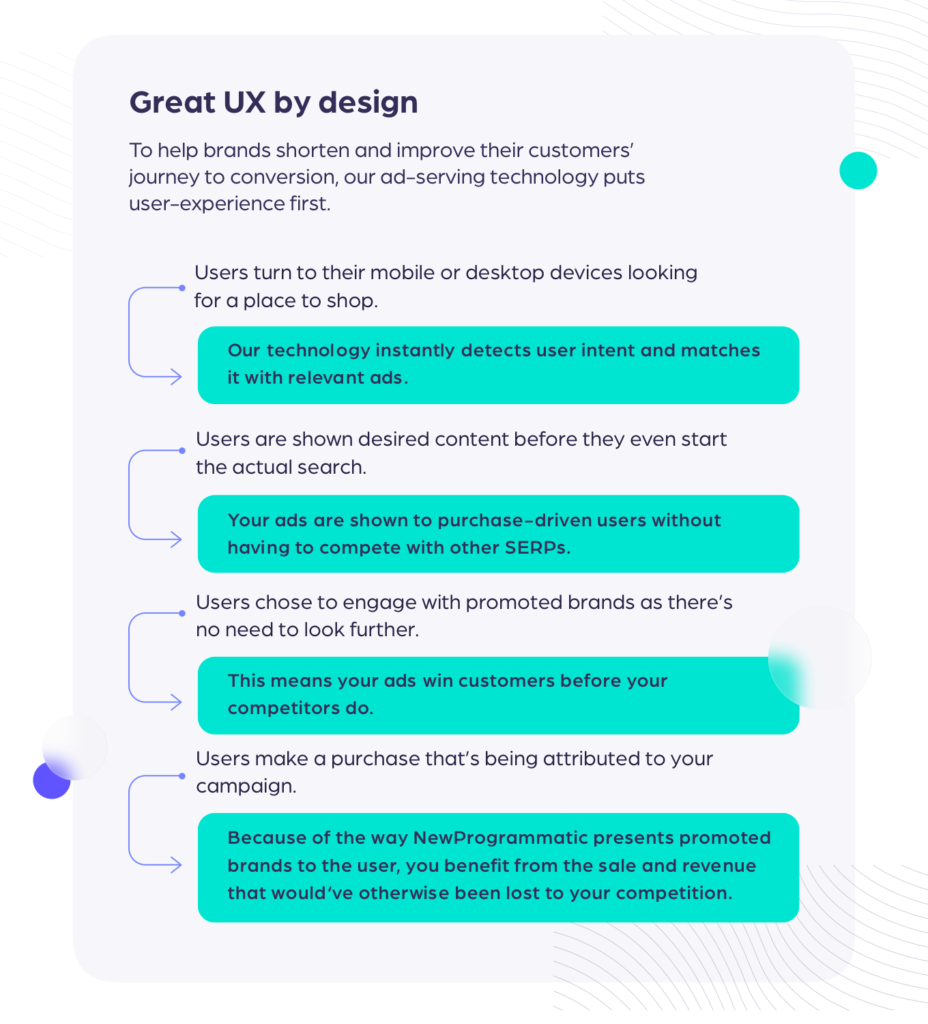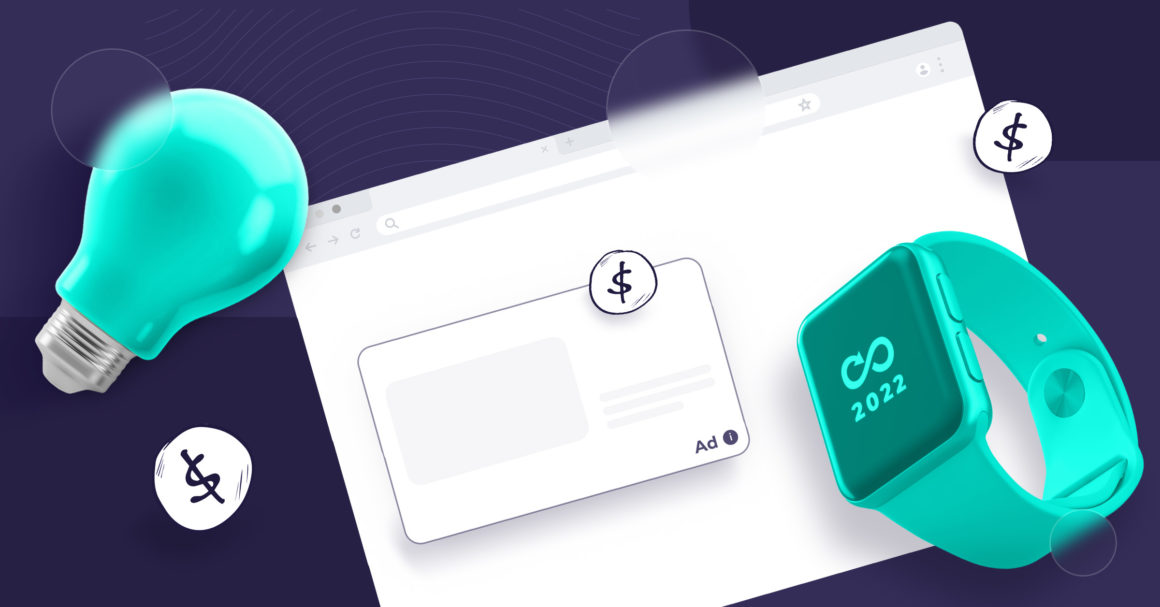From smaller enterprises to the most renowned entities on the market – brands and marketers need to stay up to date with the industry developments in order to successfully advertise their services and products to the right target audience. Everybody involved in the marketing business has already had a chance to witness the capabilities of programmatic campaigns to open a new door for streamlining user acquisition or increasing brand awareness. These solutions have been defining the world of online advertising for years now.
But every year, inventions and improvements in ad-tech technology, as well as new advertising possibilities, emerge – and 2022 will be no different.
The below list of programmatic trends in 2022 will make a great cheat sheet for every marketer and brand looking to scale their business.
Key trends for programmatic advertising in 2022
In this article, we have listed a set of the most important programmatic trends for 2022. Following those should be undoubtedly a significant point of any brand’s and advertiser’s agenda for this year.
It highlights the pivotal directions that the programmatic advertising industry will follow in the months to come, and as the year progresses, the programmatic advertising world will have a chance to track trends’ relevancy and adjust strategies.
UX-centric approach
One of the key programmatic advertising trends for 2022 for all the brands and advertisers is putting an increased effort into the UX. User demands are changing over time, so it is crucial to be regularly updated about the latest trends and behaviors.
Currently, brands need to take really good care of the user experience while being presented with their campaigns. As the audience tends to base their judgment on their comfort, the wisest marketing tactics would be to deliver the highest standard of service.
A two-way trust between a brand and its audience is beneficial for the well-being of any programmatic campaign in 2022. Modern internet users are highly conscious of their privacy but are not unwilling to share their data. The trust is being built by allowing them to choose who should be processing it and for what purposes.
Another trend that really helps brands achieve a desired level of UX is sustaining proper ad relevancy and intention-based targeting. By showing already purchase-driven users content they expect, brands can easily challenge competition while still delivering a pertinent ad to the audience.

Cookieless-based approach
Rising concerns over online privacy and third-party data circulation enforced major changes to the way information about users is perceived by brands and marketers. To win the audience’s trust, a company must be following the expectations regarding the usage of data within marketing efforts.
As a shift toward safe first-party data could have been worrying about some advertisers, in 2022 the trend will only intensify. Some brands worry that changes will disable all possible ways of audience targeting, but this concern is unfounded. With programmatic ad buying solutions relying on first-party data, advertisers are able to target their audience precisely based on their intent.
This is definitely something the whole industry should be really careful about. We recommend visiting our blogpost on the future of programmatic advertising in a cookieless world to find out more about the topic.

Leveraging first-party data
Following the patterns of third-party data processing is a trend that brands and marketers should follow in order to fulfill environmental expectations. Should a respected brand follow outdated, third-party cookies-based schemes and solutions, it could potentially lose credibility among the audience.
The marketing industry should firstly be highly aware of their target users’ preferences, and secondly, make the greatest use of first-party-based solutions. This way users’ online privacy inclinations are satisfied as the data is processed in a highly competent, safe, and professional manner.
NewProgrammatic ad exchange platform offers exactly that – proper data processing, and safe and user-compliant methods of receiving it.
Brand safety and brand visibility
Programmatic advertising enabled the whole marketing industry to really guard brands’ good reputations. The decision of trusting the programmatic buying solutions created a safe space for advertisers where they are able to filter out all the unwanted traffic and attract only a specific type of audience.
Using programmatic keyword targeting allows brands to focus on specific search queries and keywords. This filters out all the potential unwanted programmatic displays on unwanted domains.
This type of management has become a crucial part of creating a brand’s online presence and is definitely a beneficial marketing practice.
Many advertisers tend to forget how important the image of a brand (as media buyers) is when it comes to online advertising. Having a respected environment of ad display is, by all means, helpful, and raises the possibility of conversion with an engaged user is much higher.
The same solutions are being constantly used as a form of reaching the potential customer before the competition, as well as a way to build the brand’s presence and recognizability. Brand awareness among potential customers is the foundation of creating a strong position in the market. Programmatic ad tech is a solution that enables that at an unparalleled-before rate and precision.

New Generations of the programmatic advertising audience
The two newest generations of consumers and media users are revolutionary for the advertising industry, as both of them have been raised with broad access to technologies. Now that Gen Z and Millennials are making purchase decisions and are responsible for market trends, their behaviors and preferences should be taken into serious consideration by all the marketing industry – the programmatic field in particular.
New technology as a platform to deliver ads
With younger consumers being more technologically advanced and competent with different kinds of devices, it would be unwise for advertisers to neglect the rising importance of innovation.
The numbers represent it clearly. Statista presented us with research findings that claimed that in 2020 there were 83.7 million AR (Augmented Reality) and a combined 50,2 million VR (Virtual Reality) users in the U.S. only. This has become even more important, as both AR and VR tools are starting to be the cornerstone of metaverse advertising that is being intensely developed as per Q1 of 2022.
The predictions are that by 2023 the U.S. AR user count will increase to 110.1 million while the VR device user count will exceed 66 million. This exponential rise in popularity of those tech solutions will in fact be something to explore in the future, especially with metaverse possibly reaching new highs in the years to come.

Connected TV (CTV) ad opportunities
Programmatic CTV is also a trend that has been visible for a long time, and it refers to increasing accessibility to internet-connected TV devices. In 2022 Connected TV is more popular than ever, and streaming services have finally started to monetize their immense traffic by advertising.
Brands are once again given another chance to reach a new type of customer by accessing the content provider users’ first-party data. For advertisers, it means that they could narrow their targeting even more and contextually try to interest a specified type of viewer.
Search advertising possibilities
Voice search functionality was at first (when introduced at the beginning of the second decade of the XXI century) only innovation, and the market would not perceive it as a groundbreaking change.
But with the improvements in artificial intelligence, major upgrades of virtual assistants, and the introduction of smart devices (such as speakers), people have started to use voice search more intensively. Voicebot.ai report shows that over a third of adults have used this kind of search, and the numbers will be rising.
This tool is not only a great solution for visually and physically impaired users but also something that programmatic advertising professionals should look carefully into. Voice queries are usually longer than what a user would search by typing (even up to 5 or 6 words long), and most often have a form of a question rather than a keyword cluster.

The video ads sector is keeping its trajectory
Video formats are something that advertising brands embraced a few years ago when text-based formats had to give the floor to newer solutions. This is strongly based on user preferences, and the rising popularity of TikTok is only another proof of the concept.
Ephemeral video clips are clearly something that the audience seeks in 2022, and it’s a perfect opportunity for advertisers. The digital ad spend for video formats has also been rising, and as Statista predicts, in 2022, it will reach $43 billion. It is almost double of video programmatic ad spend from 2019, which was $24.5 billion.

Mobile importance
A good idea for any advertiser would be to really focus on mobile advertising opportunities. This relates both to implementing more mobile-friendly solutions and introducing programmatic advertising to new portable devices.
Wearable tech is yet another way of reaching ad receivers, as smartwatches, smart bands, and other smart devices become more accessible and are equipped with better screens now.
The marketing industry has already become almost entirely mobile-optimized in a response to user preferences and year-by-year mobile growth. This is definitely something that brands and advertisers should stick to and definitely good practice for any marketing team member.
Buy now – pay later platforms
When analyzing buy now-pay later platforms, marketers should have two perspectives in mind. The first one is user-centric, and the other focuses on how brands could benefit from engaging with such traffic sources.
For a brand, it is always beneficial to narrow the campaigns down to those users, who are already convinced to make a purchase. By approaching positive consumers, the marketer increases the conversion chance of a programmatic ad campaign, while basically doing the user a real favor.
The well-targeted campaign will be a perfect response to the search query, with the possibility of customer bouncing significantly decreasing. The buy now – pay later model enables more brand safety, as the trail of the user is more likely to lead to a conversion.
The studies show that younger adults have currently very little trust for any form of loan or credit. Simply delaying the payment without going into any debt is a perfect answer for their needs.
One of the most prolific buy now-pay later is of course Klarna, which recorded $80 billion gross merchandise volume in 2021. Offering both highly efficient Search Autocomplete and Tiles traffic, it showcases how efficient NewProgrammatic features can become in a capable advertiser’s hands.
What is also a very important peculiarity of this type of online shopping, is the fact that it most usually revolves around transactions of a higher cost. Buy now – pay later platforms are obviously most widely used during more expensive purchases. This is why it’s a very convenient tool for those brands that want to attract higher-spending users.

Vertical search engines
In order to receive exact and already-filtered search results, users have begun to pay increased attention to specialized search engines. Vertical search programmatic advertising allows the brands to really omit the traditional, horizontal search engine (like Google) struggle to position the ads.
Instead of that, marketers can reach users based on their intentions within vertical search engines. Those are really easy to find out, as in this case, the audience more eagerly shares their data. Most often, they visit the search engine in order to make a purchase. Reaching an already-convinced audience is one of the most effective strategies in the industry, and is highly recommended for all advertisers.
In-house programmatic advertising
Another trend that brands are currently intensively following, is the progressive shift towards in-house programmatic advertising.
In the past, due to the technological complexity of programmatic solutions, this particular area of marketing was slightly falling behind other fields of advertising in terms of the ongoing in-house shift. As most of the marketing (i.e., traditional advertising) was gradually absorbed by companies, marketing professionals focusing on programmatic ad solutions were still mostly outsourced. But as a broad understanding of the topic rose, more and more experts have been hired to operate in-house for the companies.
The in-house form of conducting campaigns imposes the necessity of having only the highest-skilled professionals on board. In this configuration, utilizing a trusted programmatic advertising platform could outperform any other form of outsourced programmatic ads operations.
This particular type of employment allows marketers to better fathom and plan a brand’s programmatic ads strategy, decreasing the operation’s expenditure and making space for more extensive programmatic ad spending. It is also a brilliant way of holding more control over successive steps of the campaign planning and bringing transparency to programmatic campaigns – without any external middlemen.
According to IAB’s 2020 research, as much as 74% of EU-based programmatic advertising was conducted in-house, while in the U.S. it reached 69%. The researchers expect both of those values to rise in the following years.

Intent-based ads
Based on 1st party processed by trusted publishers, quality programmatic advertising platforms allow marketers to bid for digital ad space that best reaches those members of the audience, who show the most probable intention of purchase.
While in the past this approach was heavily reliant on third-party cookies, nowadays thanks to programmatic advertising technology, marketers and brands are able to operate on first-party data.
Once again, it is an optimal practice for companies, especially since, although cookies and third-party data are still present online, they soon will be discarded. It’s also a matter of brand safety of the respected entities to follow new, privacy-focused trends. Otherwise, users could not be so eager to engage with a campaign they are being shown.
Contextual targeting
With programmatic advertising platforms, it becomes possible to display ads in accordance with the context of the website. Brands shall use this functionality for precise audience targeting – for example, sportswear brands will benefit most from programmatic display on sports-related websites, and not just any other domain. Approaching an interest-correlative audience thoroughly increases the chance of conversion, as relevant content will simply attract more users’ attention.
Keyword targeting
It has also become a good practice for advertisers to narrow down their campaigns by using keyword targeting. This is yet another form of contextual advertising which allows marketers to focus on bidding for a certain audience. This allows brands to reach a highly qualified and marginal type of relevant users, and also filter out all the unwanted traffic.
Although this method of targeting has been already recognized by worldwide brands for a long time, the new, cookieless online environment highlights the best qualities of this feature – brand safety and precision.

Conclusions
Every marketer and each brand that wants to stay relevant needs to pay close attention to trending user-behavior patterns, preferred technologies, and ad formats. This is to ensure the maximum efficiency of their campaigns.
Up-to-date knowledge of all the latest programmatic advertising trends is the only way for brands to fully reach the potential of their marketing campaigns. Escalating intent-based and contextual targeting is one way to do that.
Most of the programmatic trends for 2022 will be continuations of what the industry started noticing in the previous years. Still, neglecting those could turn out to be a critical mistake, as doing so could potentially decelerate brand development.
To see how NewProgrammatic could help ads thrive




